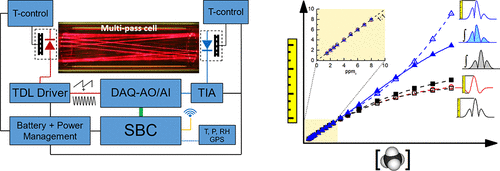Our official English website, www.x-mol.net, welcomes your
feedback! (Note: you will need to create a separate account there.)
Development of a Sub-ppb Resolution Methane Sensor Using a GaSb-Based DFB Diode Laser near 3270 nm for Fugitive Emission Measurement
ACS Sensors ( IF 8.2 ) Pub Date : 2022-01-20 , DOI: 10.1021/acssensors.1c02444 Jalal Norooz Oliaee 1 , Nicaulas A Sabourin 2 , Simon A Festa-Bianchet 3 , James A Gupta 2 , Matthew R Johnson 3 , Kevin A Thomson 1 , Greg J Smallwood 1 , Prem Lobo 1
ACS Sensors ( IF 8.2 ) Pub Date : 2022-01-20 , DOI: 10.1021/acssensors.1c02444 Jalal Norooz Oliaee 1 , Nicaulas A Sabourin 2 , Simon A Festa-Bianchet 3 , James A Gupta 2 , Matthew R Johnson 3 , Kevin A Thomson 1 , Greg J Smallwood 1 , Prem Lobo 1
Affiliation

|
A challenge for mobile measurement of fugitive methane emissions is the availability of portable sensors that feature high sensitivity and fast response times, simultaneously. A methane gas sensor to measure fugitive emissions was developed using a continuous-wave, thermoelectrically cooled, GaSb-based distributed feedback diode laser emitting at a wavelength of 3.27 μm to probe methane in its strong ν3 vibrational band. Direct absorption spectra (DAS) as well as wavelength-modulated spectra (WMS) of pressure-broadened R(3) manifold lines of methane were recorded through a custom-developed open-path multipass cell with an effective optical path length of 6.8 m. A novel metrological approach was taken to characterize the sensor response in terms of the linearity of different WMS metrics, namely, the peak-to-peak amplitude of the X2f component and the peak and/or the integrated area of the background-subtracted quadrature signal (i.e., Q(2f – 2f0)) and the background-subtracted 1f-normalized quadrature signal (i.e., Q(2f/1f – 2f0/1f0)). Comparison with calibration gas concentrations spanning 1.5 to 40 ppmv indicated that the latter WMS metric showed the most linear response, while fitting DAS provides a traceable reference. In the WMS mode, a sensitivity better than 1 ppbv was achieved at a 1 s integration time. The sensitivity and response time are well-suited to measure enhancements in ambient methane levels caused by fugitive emissions.
中文翻译:

使用 3270 nm 附近的基于 GaSb 的 DFB 二极管激光器开发亚 ppb 分辨率甲烷传感器,用于无组织发射测量
移动测量逃逸甲烷排放的一个挑战是同时具有高灵敏度和快速响应时间的便携式传感器的可用性。一种用于测量无组织排放的甲烷气体传感器是使用连续波、热电冷却、基于 GaSb 的分布式反馈二极管激光器开发的,该激光器发射波长为 3.27 μm,以探测强 ν 3中的甲烷振动带。直接吸收光谱 (DAS) 以及压力加宽的甲烷的 R(3) 歧管线的波长调制光谱 (WMS) 通过定制开发的开放路径多通道单元记录,有效光程长度为 6.8 m。采用一种新的计量方法来根据不同 WMS 度量的线性度来表征传感器响应,即X 2 f分量的峰峰值幅度和背景减去的峰值和/或积分面积正交信号(即Q (2 f – 2 f 0 ))和减去背景的 1 f归一化正交信号(即Q (2 f/1 f – 2 f 0 /1 f 0 ))。与跨越 1.5 至 40 ppm v的校准气体浓度进行比较表明,后一种 WMS 指标显示出最线性的响应,而拟合 DAS 提供了可追溯的参考。在 WMS 模式下,在 1 s 积分时间内获得了优于 1 ppb v的灵敏度。灵敏度和响应时间非常适合测量由无组织排放引起的环境甲烷水平的提高。
更新日期:2022-01-20
中文翻译:

使用 3270 nm 附近的基于 GaSb 的 DFB 二极管激光器开发亚 ppb 分辨率甲烷传感器,用于无组织发射测量
移动测量逃逸甲烷排放的一个挑战是同时具有高灵敏度和快速响应时间的便携式传感器的可用性。一种用于测量无组织排放的甲烷气体传感器是使用连续波、热电冷却、基于 GaSb 的分布式反馈二极管激光器开发的,该激光器发射波长为 3.27 μm,以探测强 ν 3中的甲烷振动带。直接吸收光谱 (DAS) 以及压力加宽的甲烷的 R(3) 歧管线的波长调制光谱 (WMS) 通过定制开发的开放路径多通道单元记录,有效光程长度为 6.8 m。采用一种新的计量方法来根据不同 WMS 度量的线性度来表征传感器响应,即X 2 f分量的峰峰值幅度和背景减去的峰值和/或积分面积正交信号(即Q (2 f – 2 f 0 ))和减去背景的 1 f归一化正交信号(即Q (2 f/1 f – 2 f 0 /1 f 0 ))。与跨越 1.5 至 40 ppm v的校准气体浓度进行比较表明,后一种 WMS 指标显示出最线性的响应,而拟合 DAS 提供了可追溯的参考。在 WMS 模式下,在 1 s 积分时间内获得了优于 1 ppb v的灵敏度。灵敏度和响应时间非常适合测量由无组织排放引起的环境甲烷水平的提高。




















































 京公网安备 11010802027423号
京公网安备 11010802027423号